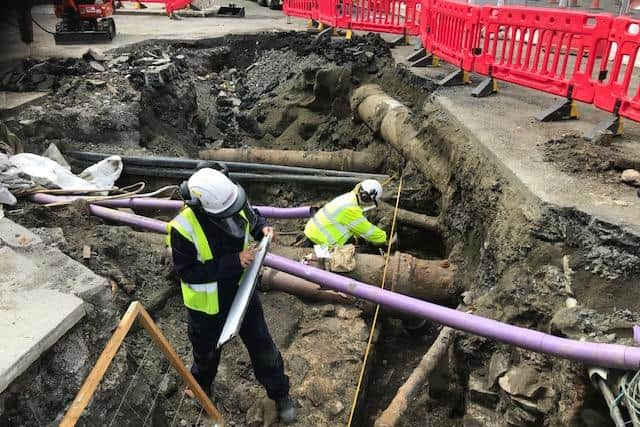Cannonball fired at church during 16th-century siege uncovered beneath route of Edinburgh tram extension
Archaeologists who dug up the iron cannonball outside a 15th-century church believe it was likely to have been deployed during the “Siege of Leith” in the mid-16th century, which triggered the end of the Auld Alliance.
The cannonball, which is around 4.5 inches in diameter, is the latest in a series of finds to emerge from a series of digs on Constitution Street. The digs got underway in November 2019, shortly before construction work on the new tram line linking to the city centre and the waterfront began.
Advertisement
Hide AdAdvertisement
Hide AdThe cannonball, which will now be analysed extensively to try to work out how old it is, was recovered from a trench outside the graveyard at South Leith Parish Church, which dates back to 1483, some 300 years before Constitution Street itself was built.
More than 350 bodies have previously been discovered beneath the route of the tram extension. Some are thought to date as far back as 1300 from when the first medieval burial ground was created.
In December, archaeologists revealed they had uncovered the remains of a medieval woman they believe may have been murdered and “dumped” in a pit more than 700 years ago. They were left baffled by the discovery of the remains of a woman found on her own in a “crouching position” in a stand-alone pit.
Around 3,000 French troops were brought in to defend the port of Leith in 1548 by Mary of Guise, mother of Mary Queen of Scots. Despite extensive efforts by the French to strength their fortifications, their occupation was brought to an end in 1560 after English forces, assisted by rebellious Protestant Scottish factions, arrived in the port.
The fortifications were bombarded from huge batteries, including two created on high ground to the south of the current Leith Links. A truce was called in the wake of the death of Mary of Guise and both the English and the French agreed to leave Leith after the signing of the Treaty of Edinburgh.


John Lawson, the city council’s archaeologist, who has been overseeing the work on Constitution Street since the first tram works began in the area in 2007, said the cannonball was found in an area where remains of Leith’s fortifications had previously been discovered.
Mr Lawson said: “We’ve been working on site again for about five weeks since the start of the year and it’s been quite slow.
Advertisement
Hide AdAdvertisement
Hide Ad“But it was a real surprise and really exciting to find this cannonball, because it probably dates from the Siege of Leith.
"We think it was probably shot by the English and Protestant forces on the other side of Leith Links.


“The church would have been a very prominent landmark just inside the fortifications.
"There would have been besieging forces on the other side of Leith Links firing into the town. It would have been an obvious target to start lobbing shells into.
"The really exciting thing is that this could be tangible evidence of the siege of Leith. It's really interesting as an archaeologist to come across an artefact that can be linked to a specific historic event.”
A message from the Editor:


Thank you for reading this article. We're more reliant on your support than ever as the shift in consumer habits brought about by coronavirus impacts our advertisers.
If you haven't already, please consider supporting our trusted, fact-checked journalism by taking out a digital subscription.
Joy Yates
Editorial Director
Comments
Want to join the conversation? Please or to comment on this article.